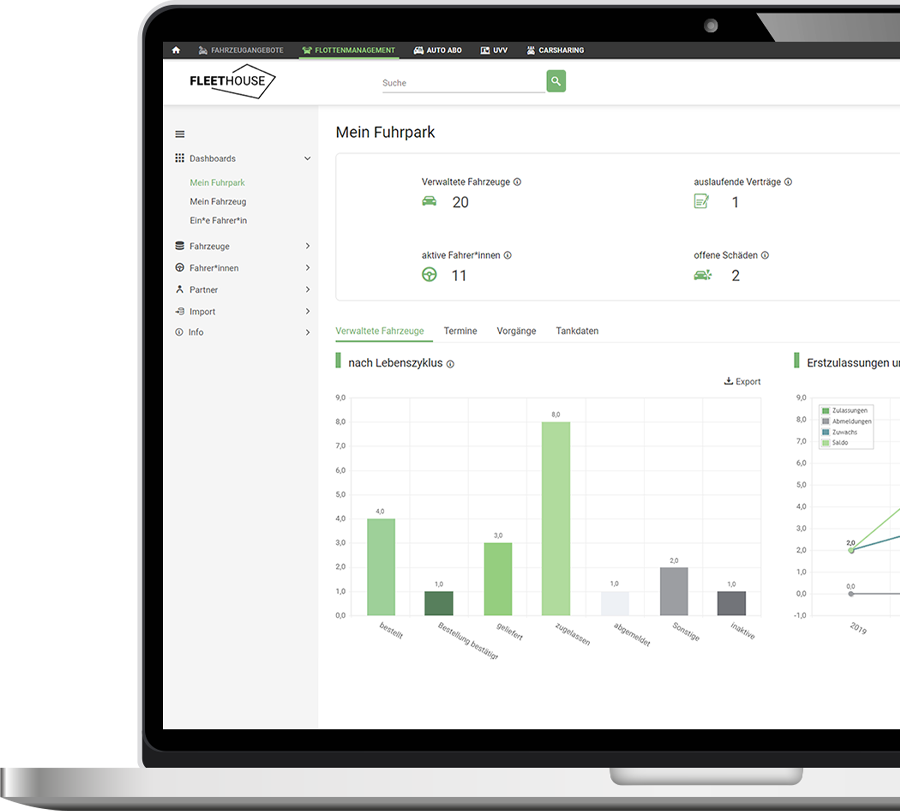Many fleet managers are constantly faced with the challenge of keeping fleet costs in check. Cost drivers in the vehicle fleet can have various causes – they range from increased fuel consumption to unplanned repairs and maintenance. In order to minimize these costs, it is important to identify the main cost factors and take suitable measures to counteract them. We will show you the biggest cost drivers and explain the means and solutions you can use to reduce your fleet costs.
Contents
Fixed costs in the vehicle fleet
Fixed costs are costs that are incurred every year. They are independent of the capacity utilization or the actual use of the vehicles and therefore remain constant.
Examples of fixed costs in the vehicle fleet:
- Vehicle acquisition costs and the costs of accessories (e.g. high-visibility vest)
- Premiums
- Inspection costs, main and exhaust gas inspection (HU/AU)
- Vehicle tax
- Stand fees (e.g. costs for garages or parking spaces)
- Personnel costs
- Insurances
- Financing costs (e.g. loans or leasing contracts)
You can find insurance or financing options at Santander.de, for example
Variable costs in the vehicle fleet
In contrast to fixed costs, variable costs depend, among other things, on capacity utilization and the actual use of the vehicles. They rise or fall depending on how many vehicles are used and how intensively they are used.
Examples of variable costs in the vehicle fleet:
- Fuel costs or costs for charging current for e-cars
- Maintenance and repair costs
- Costs for tires
- Tolls

Identify cost drivers in the fleet
Cost drivers in the vehicle fleet can have a significant impact on a company’s financial performance. The identification of these is therefore of great importance. In view of the many cost drivers associated with operating a fleet, it is important to take a closer look at them.
The introduction of certain measures can help to achieve long-term cost savings.
1. vehicle maintenance and inspections
Important inspections and regular vehicle maintenance in accordance with the manufacturer’s specifications are crucial to avoid expensive repairs. By detecting wear or damage at an early stage, expensive downtimes can be minimized and unforeseen costs reduced. The direct conclusion of cost-effective maintenance contracts when purchasing a vehicle can also save additional money.
2. introduction of pool vehicles
The introduction of pool vehicles in the fleet can help to significantly reduce operating costs. They have the great advantage that they can be used jointly by the drivers, thus reducing the number of vehicles required in the company.
If, on the other hand, each employee uses their own company car, each of these vehicles incurs costs for purchase, insurance, fuel and maintenance. These costs can be minimized with pool vehicles, which can lead to considerable savings in the fleet. Clear booking systems and guidelines then ensure that the vehicles are used efficiently and that no unnecessary costs are incurred.

3. fuel management
The use of fuel cards or the precise monitoring of fuel consumption can reduce fuel costs, among other things. The use of alternative drives or hybrid vehicles can also lead to long-term savings in fuel costs. An anticipatory driving style and refueling at the right time can also effectively reduce costs.
4. fleet management software
The use of specialized fleet management software can help you to manage your fleet more efficiently. Functions such as vehicle monitoring and data analysis enable better control over cost factors and help to make strategic decisions.
Fleet Management
With fleet management software from Fleethouse, you have the right partner at your side. Organize all tasks relating to your vehicles and keep an eye on all appointments.

5. insurance comparisons and contract negotiations
Potential savings can be achieved by regularly reviewing insurance contracts and comparing offers. However, taking out fleet insurance, where all vehicles in a fleet are bundled into a single insurance policy, also offers potential savings compared to individual insurance policies. A decisive factor in influencing the insurance premium is the combined ratio. The higher this is (meaning the more damage to the vehicles), the higher the insurance premiums.
6. tire management
Tire pressure is one of the cost drivers in a vehicle fleet. If it is too low, this can lead to increased fuel consumption. Regularly checking and maintaining the optimum tire pressure is therefore of great importance. Proper storage of tires should also not be underestimated in order to minimize wear and tear and reduce the need for premature replacement tires.
The most important facts about cost drivers in the vehicle fleet
With the right measures, the cost drivers in the vehicle fleet can be reduced.
The biggest cost drivers include high fuel costs, unplanned repairs and maintenance, as well as high insurance premiums in the event of increased claims.
By specifically controlling and optimizing cost drivers, companies can increase their efficiency and achieve long-term cost savings.
Further Fleet Knowledge
If you liked this article and would like to know more about this topic, we recommend these articles.

How to reduce fuel costs in your fleet



